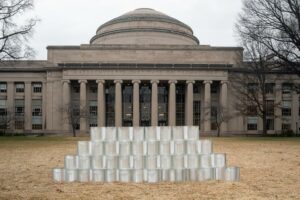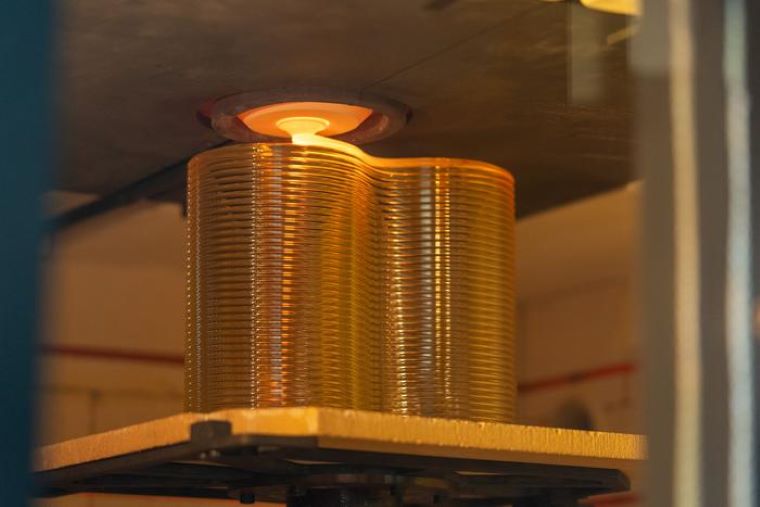Researchers from the Massachusetts Institute of Technology (MIT) have created 3D printable glass bricks that can withstand the same pressures as concrete blocks.
Built using recycled glass, the novel bricks are shaped like figure eights, allowing them to be used in modular construction efforts similar to Legos. The glass bricks can also be continuously reused even after a building has been disassembled or demolished, offering a previously unavailable level of sustainability and versatility that the construction industry calls ‘circular construction.’
“Glass is a highly recyclable material,” explained Kaitlyn Becker, assistant professor of mechanical engineering at MIT and a co-author of the paper outlining the team’s work. “We’re taking glass and turning it into masonry that, at the end of a structure’s life, can be disassembled and reassembled into a new structure or can be stuck back into the printer and turned into a completely different shape. All this builds into our idea of a sustainable, circular building material.”
Why Glass Bricks For Construction are Counterintuitive
All construction projects generate greenhouse gas emissions, from the creation and harvesting of the building materials and the actual construction to the site’s eventual demolition. Dubbed “embodied carbon,” this inherent environmental debt makes the construction industry a major polluter and a prime target for improved sustainability practices.
To search for methods to dramatically reduce construction’s embodied carbon, the MIT researchers turned to a highly recyclable and reusable material: glass. Of course, they concede that using glass as a construction material is counterintuitive since people immediately think of the fragility of most glass objects.
“Glass as a structural material kind of breaks people’s brains a little bit,” says Michael Stern, a former MIT graduate student and researcher in MIT’s Media Lab and Lincoln Laboratory.
According to Stern, founder and director of MIT spinoff Evenline, which provided the 3D printing technology used to make the team’s glass bricks, their work aimed to expand people’s perception of this cheap, widely available material.
“We’re showing this is an opportunity to push the limits of what’s been done in architecture,” he explained.
Figure Eight Shape Offers Versatility
According to the press release announcing the novel glass bricks, Stern and Becker first became fascinated with the potential of using glass in construction as undergraduates working in the university’s Glass Lab. The duo says they even learned the art of blowing glass.
“I found the material fascinating,” said Stern. “I started thinking of how glass printing can find its place and do interesting things, construction being one possible route.”
Like Stern, Becker says she was also fascinated by glass and began thinking about how the material could offer unique benefits to construction. These included the material’s potential 3D printability, recyclability, and ease of use.
“I get excited about expanding design and manufacturing spaces for challenging materials with interesting characteristics, like glass and its optical properties and recyclability,” Becker explained. “As long as it’s not contaminated, you can recycle glass almost infinitely.”
To test their idea of creating a fully printable, recyclable glass brick that was also shaped for ultimate construction versatility, the team reached out to MIT startup Evenline. That group’s latest model, the Glass 3D Printer 3 (G3DP3), pairs with a glass furnace, which can melt crushed glass into a molten printable form. The result is a machine that can turn raw glass into 3D-printed glass bricks built layer by layer into almost any desired shape. In this case, the team says it selected a figure eight shape due to its modular variability and ability to interlock easily like LEGOS.
“With the figure-eight shape, we can constrain the bricks while also assembling them into walls that have some curvature,” explained the study’s lead author, Daniel Massimino, also from MIT.


Glass Bricks Withstand Similar Pressure as Concrete Blocks
To create their first generation of 3D printable glass bricks, the researchers started with soda-lime glass, a material typically used in glass-blowing studios. Each brick was printed with a pair of cylindrical studs on the top, just like those found on LEGO bricks. This feature allows the bricks to be assembled into a wide variety of configurations, much like the versatile child’s toy.
During the printing process. the team added a buffer material between the printed layers of glass designed to help prevent scratches or cracks. This material can be removed during a building’s demolition, leaving the raw glass to be melted back down and turned into new bricks or other materials.
After printing their first batch, the team tested the strength of their new glass bricks by placing them in an industrial hydraulic press and squeezing them until they fractured. According to the study, the strongest bricks, which included a separate “interlocking feature” attached to the bottom that was not made of glass, could withstand pressures similar to those of concrete blocks commonly used in construction. The team says this success showed that their novel brick is a viable option for sustainable construction projects.
“These results suggest that most of a masonry brick could be made from printed glass,” the press release explains, “with an interlocking feature that could be printed, cast, or separately manufactured from a different material.”
Also, while the team says they have not given up on creating the same interlocking feature out of glass, they don’t consider having to make it out of something else as a “deal breaker.”
“Glass is a complicated material to work with,” Becker said. “The interlocking elements, made from a different material, showed the most promise at this stage.”
Wall Demonstrates Glass Brick’s Versatility
To demonstrate the viability of their 3D-printed invention, the researchers printed enough bricks with interlocking structures to construct a “demo” curved wall made solely of interlocking glass bricks. The wall was set up at MIT’s Killian Court.
Next, the team says it is preparing to build larger, more complex, self-supporting glass brick structures based on the lessons it has already learned from the construction and assembly of its demonstration wall.
“We have more understanding of what the material’s limits are and how to scale,” Stern said. “We’re thinking of stepping stones to buildings and want to start with something like a pavilion — a temporary structure that humans can interact with and that you could then reconfigure into a second design. And you could imagine that these blocks could go through a lot of lives.”
The Study “Additive manufacturing of interlocking glass masonry units” was published in Glass Structures and Engineering.
Christopher Plain is a Science Fiction and Fantasy novelist and Head Science Writer at The Debrief. Follow and connect with him on X, learn about his books at plainfiction.com, or email him directly at christopher@thedebrief.org.

